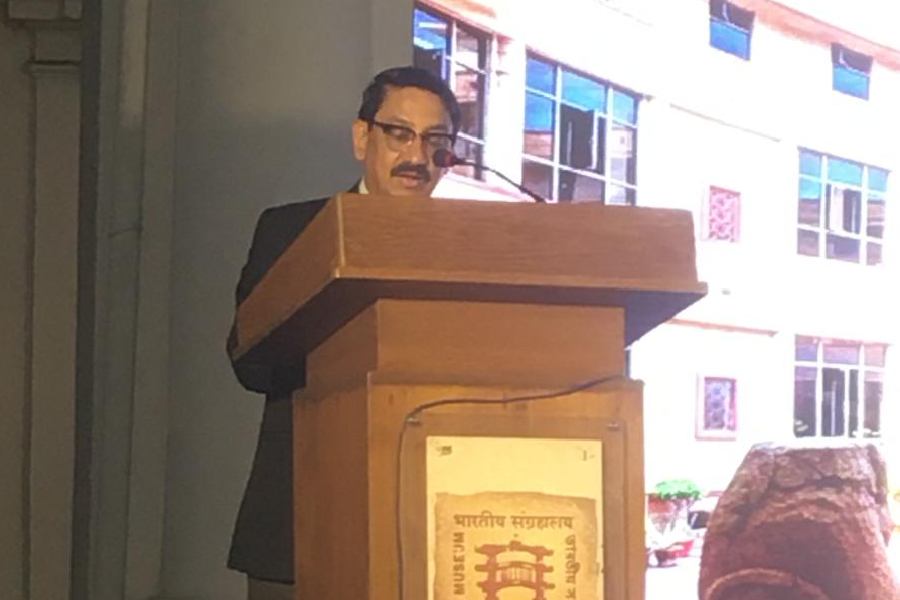Museums are not only repositories of artefacts. They are also about the lives of people.
On February 2, 1814, Nathaniel Wallich, botanist and surgeon of Danish origin, had founded the Indian Museum. It was appropriate that the 210th anniversary celebrations of the museum started on February 2 with the Nathaniel Wallich Memorial Lecture titled ‘Small is beautiful: Museums of the new age’. It was delivered by V. Venu, chief secretary, Kerala, and was about re-imagining the museum.
Venu, in his long and distinguished career, is credited with transforming museums in India. He had served as director-general of National Museum, Delhi, from 2013, turning it around and bringing to it a new life, when in 2015 he was abruptly removed. He has been instrumental in setting up a large number of small museums in Kerala. He had played a key role in the promotion of Kerala tourism and in the Incredible India campaign.
On Friday, he said he was on the premises of one of “the greatest museums of the world”. But the voices of indigenous people, the marginalised, may not always be “heard in the great museums”.
There is a movement towards smaller spaces as museums devoted to a particular community or place or work, which allows the community to participate in it. A museum cannot exist in a vacuum.
Worldwide, decolonisation as a trend has led to the setting up of museums with indigenous artefacts. In India, too, this is happening. Venu presented a list of such contemporary museums.
On top, he said, was Madhya Pradesh Tribal Museum in Bhopal. As the name indicates, the theme of the museum is the life of tribal communities, their work, their art and craft. Venu mentioned the curator’s note, which asks who the museum is for and how it is going to be meaningful. “Artisans were invited to give their ideas on art,” he said.
Kala Bhoomi of Odisha in Bhubaneswar and Arna-Jharna, the desert museum in Jodhpur, Rajasthan, were next on his list.
“Arna-Jharna’s main exhibition is an exhibition of brooms,” said Venu.
Museums can become the repository of local knowledge and skills and provide insight into socio-economic activities.
Venu pointed out that often such museums do not call themselves “museums”.
Bangalore featured prominently on the list, with the Museum of Art and Photography and the Indian Music Experience Museum. The music museum is interactive and has a strong presence online. Its aim is to connect today’s youth to Indian musical heritage, Venu said, “a strenuous challenge”.
He mentioned the recently-opened Museum of Astronomy and Space Science in Calcutta.
Venu spoke about how Kerala has become a hub of small museums. This has happened under his leadership, though he referred to himself with self-deprecating humour. “Eighteen museums have opened in the last seven years,” he said. All of them looked stunning, housed in stunningly beautiful traditional buildings, in the images that accompanied his presentation. The displays looked simple, elegant and efficient and made good use of light.
Foremost among the Kerala museums is Keralam — Museum of History and Heritage, in Thiruvananthapuram, which was set up in 2011 and which Venu curated himself. It is a nodal agency of all museums in Kerala under cultural affairs department.
But Venu spoke equally passionately about all the others, including Hill Palace Museum, Pazhassi Raja Museum and Koikkal Palace Museum. Curation has sometimes meant throwing away a lot of kitsch accumulated at the palaces and keeping the valuables.
Two museums are dedicated to M.K. Gandhi’s visits, Vaikom Satyagraha Museum and Gandhi Smriti Museum, Payannur. Gandhi had lent his support to the Vaikom Satyagraha, a nonviolent movement that wanted abolition of the harsh caste system that prevented access to the Vaikom temple.
District Heritage Museum, Ernakulam, documents the maritime history of Kochi and the region. District Heritage Museum, Thrissur, has many old artefacts. Handloom Museum in Kannur displays many weaving traditions, machines and practices. “Cooperative societies contributed the machines. We are thinking of handing over the management to the cooperative societies,” said Venu.
Two rooms that housed a prison have been converted into a local museum, Venu said. Another museum hosts a large collection of palm leaf manuscripts. Last but not the least, Thiruvananthapuram now has a Raja Ravi Varma Art Gallery.
“New museums speak to the audience. They are mindful of the visitor. They are competing with television and social media,” said Venu. “They represent a quest for identity.”
A particular people, a particular place also remind how diverse India is.
The talk was preceded by a presentation of Raga Jayjayanti on the sarod by Bhaskar Sen, with Krishnendu Paul accompanying him on the tabla.
